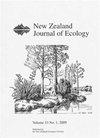What effects must be avoided, remediated or mitigated to maintain indigenous biodiversity?
IF 1.4
3区 环境科学与生态学
Q3 ECOLOGY
引用次数: 1
Abstract
New Zealand’s Resource Management Act requires avoiding, remedying or mitigating effects of human activities on the environment, including taking action to maintain terrestrial indigenous biodiversity. Here, we suggest that maintaining biodiversity requires halting its current decline, and to achieve that, New Zealand must move away from deeming only significant ecosystems and biota worthy of protection. We identify effects that must be avoided in order to maintain biodiversity, and those to be avoided unless they can be fully and promptly remediated. Effects should be avoided that reduce the extent and quality of most ecosystems and the habitats of indigenous species, including many highly modified ecosystems and habitats. Effects can be remediated only for a few, usually low-diversity and recently-established indigenous ecosystems and habitats, and we suggest a human generation (25 years) should be the maximum time to full remediation. Effects on individuals from some species’ populations (but not populations at range or environmental limits, or outliers) may be remediated through replacement in certain circumstances. The clearance and modification of young (< 25 years), non-indigenous, non-riparian ecosystems that are neither important for connectivity and buffering nor habitat for threatened or at-risk indigenous species, may have a limited adverse effect on maintaining biodiversity, but could compromise ecosystem services and remove opportunities for future restoration. The approach to avoidance we suggest would help to slow the cumulative and ongoing loss of terrestrial biodiversity caused by multiple minor effects.为了维持本地生物多样性,必须避免、补救或减轻哪些影响?
新西兰的《资源管理法》要求避免、补救或减轻人类活动对环境的影响,包括采取行动维持陆地土著生物多样性。在这里,我们建议维持生物多样性需要阻止其目前的下降,为了实现这一目标,新西兰必须不再认为只有重要的生态系统和生物群值得保护。我们确定了为了维持生物多样性必须避免的影响,以及除非能够充分和迅速地加以补救,否则必须避免的影响。应避免减少大多数生态系统和本地物种生境的范围和质量的影响,包括许多高度改变的生态系统和生境。影响只能对少数,通常是低多样性和最近建立的土著生态系统和栖息地进行补救,我们建议人类一代(25年)应该是完全补救的最长时间。对某些物种种群(但不是在范围或环境限制或异常值的种群)的个体的影响可以通过在某些情况下的替代来补救。清除和改造年轻的(< 25年)、非本地、非河岸生态系统,这些生态系统对连通性和缓冲作用既不重要,也不是受威胁或处于危险中的本地物种的栖息地,可能对维持生物多样性产生有限的不利影响,但可能损害生态系统服务并消除未来恢复的机会。我们建议的避免方法将有助于减缓由多种轻微影响引起的陆地生物多样性的累积和持续丧失。
本文章由计算机程序翻译,如有差异,请以英文原文为准。
求助全文
约1分钟内获得全文
求助全文
来源期刊

New Zealand Journal of Ecology
环境科学-生态学
CiteScore
3.00
自引率
12.50%
发文量
35
审稿时长
>36 weeks
期刊介绍:
The New Zealand Journal of Ecology is a biannual peer-reviewed journal publishing ecological research relevant to New Zealand/Aotearoa and the South Pacific. It has been published since 1952 (as a 1952 issue of New Zealand Science Review and as the Proceedings of the New Zealand Ecological Society until 1977). The Journal is published by the New Zealand Ecological Society (Inc.), and is covered by Current Contents/Agriculture, Biology and Environmental Science, GEOBASE, and Geo Abstracts.
 求助内容:
求助内容: 应助结果提醒方式:
应助结果提醒方式:


